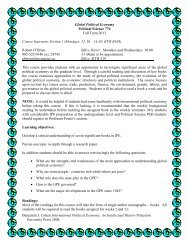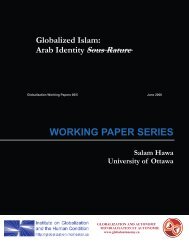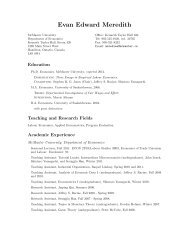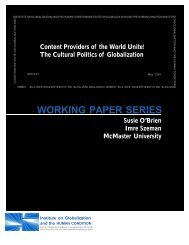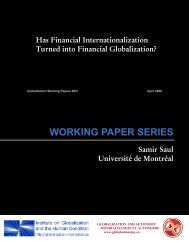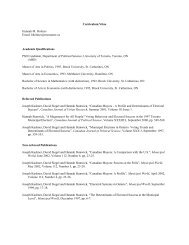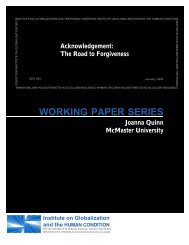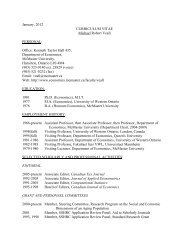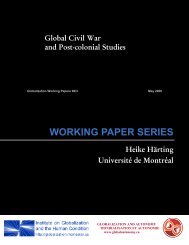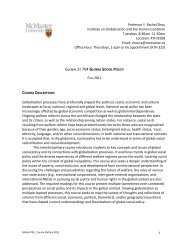A Study of Writing Assignments in Selected Canadian - McMaster ...
A Study of Writing Assignments in Selected Canadian - McMaster ...
A Study of Writing Assignments in Selected Canadian - McMaster ...
You also want an ePaper? Increase the reach of your titles
YUMPU automatically turns print PDFs into web optimized ePapers that Google loves.
A <strong>Study</strong> <strong>of</strong> <strong>Writ<strong>in</strong>g</strong> <strong>Assignments</strong> <strong>in</strong> <strong>Selected</strong> <strong>Canadian</strong><br />
Undergraduate Economics Programs<br />
Barb Bloemh<strong>of</strong><br />
c/o Department <strong>of</strong> Economics, <strong>McMaster</strong> University<br />
1280 Ma<strong>in</strong> Street West, Hamilton, Ontario, Canada L8S 4M4<br />
1-905-523-4041 telephone (direct l<strong>in</strong>e)<br />
1-905-521-8232 facsimile bloemhbl@mcmaster.ca<br />
ABSTRACT: A content analysis <strong>of</strong> course outl<strong>in</strong>es or syllabi can be a<br />
useful way to learn about assessed teach<strong>in</strong>g and learn<strong>in</strong>g activities,<br />
avoid<strong>in</strong>g some <strong>of</strong> the methodological challenges that attend surveys <strong>of</strong><br />
<strong>in</strong>structors. In recent courses at a sample <strong>of</strong> research-<strong>in</strong>tensive<br />
<strong>Canadian</strong> economics departments, <strong>in</strong>stances <strong>of</strong> economics writ<strong>in</strong>g are<br />
found to be under-represented with<strong>in</strong> the range <strong>of</strong> assessed activities. I<br />
use enrolments to calculate the proportion <strong>of</strong> courses that provide any<br />
opportunity to practice writ<strong>in</strong>g about economics subject matter. Fewer<br />
than one <strong>in</strong> five <strong>of</strong> the enrolments above the <strong>in</strong>troductory year provide<br />
practice <strong>in</strong> writ<strong>in</strong>g about economics subject matter. Some observations<br />
are also provided about the context and type <strong>of</strong> writ<strong>in</strong>g assignments<br />
<strong>of</strong>fered, <strong>in</strong> light <strong>of</strong> what is known from the higher education literature.<br />
Keywords: assessment, economics education, writ<strong>in</strong>g<br />
JEL code: A22
A Survey <strong>of</strong> <strong>Writ<strong>in</strong>g</strong> <strong>Assignments</strong> <strong>in</strong> <strong>Selected</strong> <strong>Canadian</strong><br />
Undergraduate Economics Programs<br />
ABSTRACT: A content analysis <strong>of</strong> course outl<strong>in</strong>es or syllabi can be a<br />
useful way to learn about assessed teach<strong>in</strong>g and learn<strong>in</strong>g activities,<br />
avoid<strong>in</strong>g some <strong>of</strong> the methodological challenges that attend surveys <strong>of</strong><br />
<strong>in</strong>structors. In recent courses at a sample <strong>of</strong> research-<strong>in</strong>tensive<br />
<strong>Canadian</strong> economics departments, <strong>in</strong>stances <strong>of</strong> economics writ<strong>in</strong>g are<br />
found to be under-represented with<strong>in</strong> the range <strong>of</strong> assessed activities. I<br />
use enrolments to calculate the proportion <strong>of</strong> courses that provide any<br />
opportunity to practice writ<strong>in</strong>g about economics subject matter. Fewer<br />
than one <strong>in</strong> five <strong>of</strong> the enrolments above the <strong>in</strong>troductory year provide<br />
practice <strong>in</strong> writ<strong>in</strong>g about economics subject matter. Some observations<br />
are also provided about the context and type <strong>of</strong> writ<strong>in</strong>g assignments<br />
<strong>of</strong>fered, <strong>in</strong> light <strong>of</strong> what is known from the higher education literature.<br />
Keywords: assessment, economics education, writ<strong>in</strong>g<br />
JEL code: A22<br />
1. INTRODUCTION TO THE PROBLEM<br />
The academy is be<strong>in</strong>g called to exam<strong>in</strong>e how we tra<strong>in</strong> and prepare<br />
tertiary students (Adelman 2006, AACU 2007, Barr and Tagg 1995). A<br />
1
number <strong>of</strong> constructive commentaries about the state <strong>of</strong> economics<br />
education have appeared <strong>in</strong> the literature, <strong>in</strong>clud<strong>in</strong>g Salemi and<br />
Siegfried (1999), Siegfried et al. (1991a and 1991b), O’Donnell (2004),<br />
and Colander and McGoldrick (2009). However, opportunities to<br />
implement some <strong>of</strong> the recommendations <strong>in</strong> these papers appear to<br />
have been eschewed <strong>in</strong> favour <strong>of</strong> so-called “practices <strong>of</strong> convenience”<br />
aligned with the transmission model <strong>of</strong> education (Christensen Hughes<br />
and Mighty 2010, 4). Chalk and talk is a durable pattern over the fifteen<br />
years covered by three surveys <strong>of</strong> American academic economists’<br />
teach<strong>in</strong>g methods and assessments (Watts and Becker 2008; see also<br />
Becker and Watts 2001, 275).<br />
No systematic survey <strong>of</strong> discipl<strong>in</strong>ary teach<strong>in</strong>g and learn<strong>in</strong>g activities<br />
has appeared for Canada; however, there is no reason to anticipate<br />
stark differences from the American f<strong>in</strong>d<strong>in</strong>gs. Instead, the current study<br />
focuses on writ<strong>in</strong>g as a well-known <strong>in</strong>tegrative learn<strong>in</strong>g activity that is<br />
likely to be <strong>of</strong>fered <strong>in</strong> all <strong>Canadian</strong> undergraduate economics programs.<br />
The study uses complete sets <strong>of</strong> undergraduate syllabi obta<strong>in</strong>ed from a<br />
selection <strong>of</strong> economics departments to exam<strong>in</strong>e how much economics<br />
writ<strong>in</strong>g was <strong>of</strong>fered <strong>in</strong> the 2008-2009 academic year.<br />
A content analysis <strong>of</strong> all course syllabi from participat<strong>in</strong>g departments<br />
addresses a problem with the exist<strong>in</strong>g contributions to this literature.<br />
Surveys mix perception and <strong>in</strong>tent <strong>in</strong>to the data. The lengthy surveys by<br />
2
Becker and co-authors referenced above ask <strong>in</strong>structors to recall<br />
aspects <strong>of</strong> recently taught courses, without the means to verify<br />
recollections. The survey about writ<strong>in</strong>g assignments by McGoldrick<br />
(2008) also asks a subset <strong>of</strong> <strong>in</strong>dividual <strong>in</strong>structors to remember what<br />
they did <strong>in</strong> a class. The course syllabus, by contrast, is a reliable and<br />
convenient snapshot <strong>of</strong> the presence <strong>of</strong> graded writ<strong>in</strong>g; <strong>in</strong>deed, the<br />
syllabus is <strong>of</strong>ten <strong>in</strong>terpreted as a b<strong>in</strong>d<strong>in</strong>g contract between students and<br />
the <strong>in</strong>stitution. A complete set <strong>of</strong> syllabi over all courses <strong>in</strong> the program<br />
for the academic year provides an objective list <strong>of</strong> the assessed<br />
activities <strong>in</strong> the course.<br />
The syllabus is also a pragmatic reflection <strong>of</strong> how important writ<strong>in</strong>g<br />
assignments are <strong>in</strong> the eyes <strong>of</strong> the <strong>in</strong>structor, signaled by the relative<br />
value she has attached to these activities the f<strong>in</strong>al course grade. There<br />
is no reason to suppose that the percentage grade weight represents<br />
the assignment’s value or contribution to learn<strong>in</strong>g even with<strong>in</strong> a course,<br />
much less across courses. The presence <strong>of</strong> any graded writ<strong>in</strong>g <strong>in</strong> the<br />
syllabus simply signals that writ<strong>in</strong>g is perceived by the <strong>in</strong>structor as at<br />
least as valuable to learn<strong>in</strong>g <strong>in</strong> the course as other assessed activities<br />
that could be chosen.<br />
The grade weights allocated for assessed teach<strong>in</strong>g and learn<strong>in</strong>g<br />
activities represent the hidden curriculum that drives students’<br />
perceptions <strong>of</strong> where to focus effort <strong>in</strong> order to earn grades <strong>in</strong> the course<br />
3
(Snyder, 1971, cited <strong>in</strong> Gibbs and Simpson 2004/5, 4). Graded writ<strong>in</strong>g<br />
is probably not the only writ<strong>in</strong>g that students do to facilitate their<br />
learn<strong>in</strong>g; however, students are strategic <strong>in</strong> how they allocate their time<br />
(Gibbs and Simpson 2004/5, 6; Entwistle 2010, 28). The sort <strong>of</strong><br />
susta<strong>in</strong>ed writ<strong>in</strong>g <strong>in</strong> an essay or research paper may be unlikely to occur<br />
without a grade <strong>in</strong>centive.<br />
The chalk and talk survey data reworked <strong>in</strong> Schaur, Watts and<br />
Becker (2008) does not scale for class size when report<strong>in</strong>g the number<br />
<strong>of</strong> <strong>in</strong>structors surveyed who use writ<strong>in</strong>g-based assessments, which can<br />
give a mislead<strong>in</strong>g impression <strong>of</strong> the <strong>in</strong>cidence <strong>of</strong> assigned writ<strong>in</strong>g. The<br />
current study uses the enrolments for each course to measure actual<br />
student exposure to written assessments as a weighted proportion <strong>of</strong><br />
total enrolment across all economics courses, and therefore yields an<br />
enrolment-weighted measure <strong>of</strong> writ<strong>in</strong>g with<strong>in</strong> each department and<br />
across the participat<strong>in</strong>g departments <strong>in</strong> the study.<br />
Quantify<strong>in</strong>g the prom<strong>in</strong>ence <strong>of</strong> discipl<strong>in</strong>ary writ<strong>in</strong>g opportunities<br />
provides <strong>in</strong>formation about one identifiable <strong>in</strong>tegrative teach<strong>in</strong>g and<br />
learn<strong>in</strong>g experience <strong>of</strong>fered <strong>in</strong> the participat<strong>in</strong>g <strong>Canadian</strong> economics<br />
departments, to <strong>in</strong>form the ongo<strong>in</strong>g conversation about teach<strong>in</strong>g and<br />
learn<strong>in</strong>g activities <strong>in</strong> economics education. The next section discusses<br />
the data, participat<strong>in</strong>g departments and methodology. The prevalence<br />
<strong>of</strong> writ<strong>in</strong>g opportunities and some observations from the syllabus content<br />
4
analysis are presented <strong>in</strong> the results section. I provide observations<br />
from the literature about how writ<strong>in</strong>g complements the economic<br />
curriculum <strong>in</strong> the discussion section, followed by conclusions and<br />
direction for further work.<br />
2. DATA AND ANALYSIS<br />
The study data are the full set <strong>of</strong> course syllabi and f<strong>in</strong>al registration<br />
enrolment for all courses <strong>of</strong>fered <strong>in</strong> the fifteen participat<strong>in</strong>g economics<br />
departments over the period from September 2008 to April 2009 and<br />
exclud<strong>in</strong>g summer session. 1<br />
Department chairs at sixteen research<strong>in</strong>tensive<br />
universities <strong>in</strong> Canada were asked by email to participate <strong>in</strong> a<br />
study about the amount and type <strong>of</strong> writ<strong>in</strong>g required <strong>of</strong> students tak<strong>in</strong>g<br />
economics, and all but one consented to participate <strong>in</strong> the study. 2<br />
A<br />
complete set <strong>of</strong> syllabus and enrolment data for each department were<br />
collected us<strong>in</strong>g a comb<strong>in</strong>ation <strong>of</strong> email, conventional mail and web page<br />
access. 3<br />
Table 1 lists all participat<strong>in</strong>g departments. They vary <strong>in</strong> size and<br />
program focus, but all <strong>of</strong>fer major and honours undergraduate programs,<br />
as well as graduate programs conferr<strong>in</strong>g master’s and doctoral degrees<br />
<strong>in</strong> economics. Twelve <strong>of</strong> the fifteen are <strong>in</strong> the top fifteen <strong>Canadian</strong><br />
<strong>in</strong>stitutions accord<strong>in</strong>g to the RePEc rank<strong>in</strong>g <strong>of</strong> the top 25% <strong>of</strong> economics<br />
5
departments. 4<br />
The participat<strong>in</strong>g departments therefore reflect wellregarded<br />
<strong>Canadian</strong> economics departments.<br />
><br />
The size <strong>of</strong> a department dur<strong>in</strong>g the academic year, def<strong>in</strong>ed as the<br />
total enrolment <strong>in</strong> all courses, is calculated as a simple sum <strong>of</strong> the<br />
number <strong>of</strong> students <strong>in</strong> each four-month-long course <strong>of</strong>fered between<br />
September 2008 and April 2009. 5<br />
Size therefore refers to the total<br />
number <strong>of</strong> enrolments <strong>in</strong> each course credited <strong>in</strong> the regular academic<br />
year. Size is bounded from below by the total number <strong>of</strong> students<br />
served <strong>in</strong> the department because upper-level students are likely to be<br />
tak<strong>in</strong>g more than one economics course dur<strong>in</strong>g the year. Chart 1 shows<br />
the sizes <strong>of</strong> the participat<strong>in</strong>g departments. Departments range from<br />
about 2500 to about 12,000 enrolments and the average total enrolment<br />
<strong>in</strong> the participat<strong>in</strong>g departments is nearly 7300.<br />
><br />
Of all these course enrolments, which ask students to turn <strong>in</strong> any<br />
writ<strong>in</strong>g? First, calculate the sum <strong>of</strong> enrolments <strong>in</strong> all courses for which<br />
the syllabus lists a grade for a written assessment. No dist<strong>in</strong>ction was<br />
6
made between different forms or lengths <strong>of</strong> written assignment, or<br />
numbers <strong>of</strong> authors. Essay-type questions <strong>in</strong> timed exam<strong>in</strong>ations, which<br />
have evaluation rather than the creation <strong>of</strong> learn<strong>in</strong>g as their primary<br />
goal, and may be graded pragmatically us<strong>in</strong>g a different set <strong>of</strong> criteria<br />
than those used for a research paper (Fulwiler 1982, 16), were not<br />
<strong>in</strong>cluded as writ<strong>in</strong>g opportunities for purposes <strong>of</strong> this study. 6<br />
While<br />
valuable, the types <strong>of</strong> questions that can be asked <strong>in</strong> an exam<strong>in</strong>ation,<br />
and the reduced revision opportunity available <strong>in</strong> an exam<strong>in</strong>ation<br />
situation, make them quite a different form <strong>of</strong> composition than a<br />
research or term paper.<br />
With the courses with writ<strong>in</strong>g identified, I sum their enrolments and<br />
divide that number by the size <strong>in</strong> Chart 1 to calculate the proportion <strong>of</strong><br />
course enrolments with writ<strong>in</strong>g. Chart 2 shows the result<strong>in</strong>g proportion<br />
as percentages for each participat<strong>in</strong>g department. The weighted<br />
average across all fifteen departments <strong>of</strong> the proportion <strong>of</strong> courses with<br />
at least one <strong>in</strong>stance <strong>of</strong> evaluated writ<strong>in</strong>g is 11.3 percent, ris<strong>in</strong>g to 19.0<br />
percent if the first-year <strong>in</strong>troductory economics courses are excluded.<br />
><br />
For this sample, the size <strong>of</strong> the program is not <strong>in</strong>fluential on the<br />
proportion <strong>of</strong> course enrolments with writ<strong>in</strong>g opportunities. Chart 2a<br />
7
shows that a large total enrolment does not necessarily imply fewer<br />
opportunities to write (p = 0.818); <strong>in</strong>deed, the largest department <strong>of</strong>fered<br />
more than the average number <strong>of</strong> writ<strong>in</strong>g opportunities. The slight<br />
negative relationship between program size and proportion <strong>of</strong> upper<br />
level classes with writ<strong>in</strong>g opportunities <strong>in</strong> Chart 2b is not significantly<br />
different from zero (p = 0.137).<br />
However, the size <strong>of</strong> the honours program could be <strong>in</strong>fluential. On<br />
the one hand, a large honours program relative to the <strong>in</strong>take <strong>in</strong><br />
pr<strong>in</strong>ciples may mean that relatively many students get to write a senior<br />
thesis; conversely, smaller honours programs may imply more<br />
<strong>in</strong>structional resources per capita, and therefore could mean more<br />
writ<strong>in</strong>g opportunities. A very rough idea <strong>of</strong> the size <strong>of</strong> the honours<br />
program relative to total enrolment is the sum <strong>of</strong> senior thesis course<br />
enrolment as a proportion <strong>of</strong> the enrolment <strong>in</strong> the pr<strong>in</strong>ciples <strong>of</strong><br />
microeconomics course; for programs which did not have an honours<br />
sem<strong>in</strong>ar, the enrolment <strong>of</strong> a s<strong>in</strong>gle fourth-year honours program required<br />
course was substituted (for example, senior microeconomic theory).<br />
The sample correlation coefficient between size <strong>of</strong> program and<br />
proportion <strong>of</strong> writ<strong>in</strong>g opportunities is 0.38. The relationship is displayed<br />
<strong>in</strong> Chart 3.<br />
><br />
8
Chart 4 shows that departments with higher total enrolments <strong>in</strong> the<br />
sample tended to have more large classes; <strong>in</strong> every department, though,<br />
classes became smaller on average as the student progressed through<br />
the program. If the honours sem<strong>in</strong>ar is excluded, then assignments<br />
worth between 10% and 50% account for more than 97% <strong>of</strong> all writ<strong>in</strong>g,<br />
and for more than 98% <strong>of</strong> all student enrolments, <strong>in</strong> these classes. For<br />
these assignments, there is a significant negative correlation between<br />
class size and the proportion <strong>of</strong> the f<strong>in</strong>al grade made up by writ<strong>in</strong>g (r = -<br />
0.4915), illustrated <strong>in</strong> Chart 5. Larger classes tend to use other<br />
assessments for more <strong>of</strong> the f<strong>in</strong>al grade.<br />
><br />
><br />
The content analysis confirmed the prior belief that traditional test<strong>in</strong>g<br />
was the predom<strong>in</strong>ant assessment method for this sample, just as Watts<br />
and Becker (2008) found <strong>in</strong> their surveys <strong>in</strong> the United States. The<br />
writ<strong>in</strong>g assignments were diverse, rang<strong>in</strong>g from simple report<strong>in</strong>g<br />
(summaries <strong>of</strong> someone else’s writ<strong>in</strong>g, such as an economic model or<br />
journal article), through <strong>in</strong>dustry studies, research essays <strong>in</strong>volv<strong>in</strong>g<br />
<strong>in</strong>quiry (<strong>in</strong>tegrative writ<strong>in</strong>g <strong>in</strong> which puzzles <strong>in</strong> the literature are actively<br />
9
explored), and senior theses with literature reviews and empirical work.<br />
Team projects were common <strong>in</strong> some departments. One participat<strong>in</strong>g<br />
department did <strong>of</strong>fer a writ<strong>in</strong>g assignment <strong>in</strong> a required microeconomic<br />
theory course.<br />
All <strong>of</strong> the fifteen participat<strong>in</strong>g departments required some writ<strong>in</strong>g <strong>of</strong><br />
their honours students, but it would not be accurate to describe a<br />
“traditionally-formatted course” <strong>in</strong> this sample as hav<strong>in</strong>g two tests plus a<br />
paper, as Cohen and Spencer (1993, 219) do. Two-thirds <strong>of</strong> the<br />
departments <strong>of</strong>fered an honours sem<strong>in</strong>ar organized around significant<br />
scholarly writ<strong>in</strong>g on a topic which, unlike most <strong>of</strong> the writ<strong>in</strong>g described <strong>in</strong><br />
the syllabi, was <strong>of</strong>ten student-chosen with<strong>in</strong> an <strong>in</strong>structor-specified<br />
broad topic area or theme.<br />
All participat<strong>in</strong>g departments showed statements <strong>in</strong> the syllabi about<br />
the value <strong>of</strong> written assignments. At some <strong>in</strong>stitutions, the content<br />
analysis picked up a departmental commitment to writ<strong>in</strong>g. A mandatory<br />
course organized around writ<strong>in</strong>g was <strong>of</strong>fered by one participat<strong>in</strong>g<br />
department. Two other departments had a requirement that a student<br />
demonstrate pr<strong>of</strong>iciency <strong>in</strong> written expression. 7<br />
Despite this, not all <strong>of</strong><br />
the programs that clearly <strong>in</strong>dicated an explicit writ<strong>in</strong>g requirement<br />
showed a high proportion <strong>of</strong> writ<strong>in</strong>g opportunities. Two <strong>of</strong> the<br />
participat<strong>in</strong>g departments could conceivably confer a general (non-<br />
10
honours) economics degree on someone who had not a s<strong>in</strong>gle <strong>in</strong>stance<br />
<strong>of</strong> writ<strong>in</strong>g <strong>in</strong> the discipl<strong>in</strong>e.<br />
One observation about this census <strong>of</strong> course syllabi <strong>in</strong> these selected<br />
departments is that very few syllabi laid out an explicit set <strong>of</strong> learn<strong>in</strong>g<br />
objectives. 8<br />
Nearly all <strong>of</strong> the syllabi focused <strong>in</strong>stead on the content that<br />
would be covered, <strong>of</strong>ten from the recommended textbook or read<strong>in</strong>g list.<br />
Fewer than 5% <strong>of</strong> the courses represented <strong>in</strong> this study listed learner<br />
outcomes such as what skills a student would learn, or how a student<br />
would change or be able to do as a result <strong>of</strong> tak<strong>in</strong>g the course.<br />
3. DISCUSSION<br />
The f<strong>in</strong>d<strong>in</strong>gs represent only a subset <strong>of</strong> the total number <strong>of</strong> <strong>Canadian</strong><br />
economics programs and should be <strong>in</strong>terpreted carefully. Although the<br />
candidate economics departments <strong>in</strong>vited to participate were chosen to<br />
represent research-<strong>in</strong>tensive universities and programs, the results can<br />
only apply to the <strong>in</strong>dividual departments that agreed to participate and<br />
certa<strong>in</strong>ly cannot be said to reflect a country-wide average. Furthermore,<br />
not all students avail themselves <strong>of</strong> learn<strong>in</strong>g opportunities with the same<br />
degree <strong>of</strong> fidelity to the process, so although on average writ<strong>in</strong>g is an<br />
engag<strong>in</strong>g learn<strong>in</strong>g activity, its impact will certa<strong>in</strong>ly vary from student to<br />
student.<br />
11
It would be hard to argue that economists do not believe writ<strong>in</strong>g is<br />
valuable. The data show programs with explicit writ<strong>in</strong>g requirements.<br />
There is even a core theory course that had a written assignment.<br />
However, the data also show that <strong>in</strong> a number <strong>of</strong> the participat<strong>in</strong>g<br />
departments there were very few or no writ<strong>in</strong>g opportunities at the<br />
second or third year level. Students could conceivably take the honours<br />
sem<strong>in</strong>ar without any prior opportunity to master discipl<strong>in</strong>e-specific<br />
<strong>in</strong>formation literacy and written communication skills. The learn<strong>in</strong>g<br />
objectives alluded to <strong>in</strong> the syllabi for these capstone experiences<br />
<strong>in</strong>volve primarily data and econometric skills, which suggests that<br />
adequate research and writ<strong>in</strong>g pr<strong>of</strong>iciencies might be assumed.<br />
Students may need opportunities to practice devis<strong>in</strong>g and follow<strong>in</strong>g a<br />
substantive economic issue through the literature and <strong>in</strong>tegrat<strong>in</strong>g their<br />
f<strong>in</strong>d<strong>in</strong>gs <strong>in</strong> written form before they <strong>in</strong>tegrate those skills with numeracy<br />
skills <strong>in</strong> the program’s capstone experience.<br />
The education literature calls for writ<strong>in</strong>g to be a part <strong>of</strong> the economics<br />
curriculum (e.g., Siegfried et al. 1991b, 217-218; Salemi and Siegfried<br />
1999, 358; Becker [2000, 117] stops short <strong>of</strong> actually call<strong>in</strong>g for writ<strong>in</strong>g).<br />
There are two themes <strong>in</strong> the literature that perta<strong>in</strong> to economics writ<strong>in</strong>g.<br />
The first is authentic assessment, what the discipl<strong>in</strong>e sometimes calls<br />
“do<strong>in</strong>g economics” (McGoldrick 2008), and what Hansen alluded to<br />
when he recommended teach<strong>in</strong>g pr<strong>of</strong>iciencies (2001; 1986). Authentic<br />
12
assessment is def<strong>in</strong>ed as any graded task that requires the student to<br />
engage <strong>in</strong> mean<strong>in</strong>gful or worthy activities that are analogous to expert<br />
use <strong>of</strong> the content (Wigg<strong>in</strong>s 1993, 229). Better examples <strong>of</strong> authentic<br />
assessment are performances that ma<strong>in</strong>ta<strong>in</strong> a fidelity to the skills and<br />
competencies that a practitioner <strong>of</strong> the subject matter would actually<br />
carry out (Cumm<strong>in</strong>g and Maxwell 1999). For economics, writ<strong>in</strong>g is a<br />
form <strong>of</strong> authentic assessment, a platform for performances that are<br />
congruent with, if sometimes somewhat contrived examples <strong>of</strong>, what<br />
economists do.<br />
The second theme from the literature is the development <strong>of</strong><br />
substantive reason<strong>in</strong>g or critical th<strong>in</strong>k<strong>in</strong>g skills. An assignment that<br />
requires “[a]ctive, persistent and careful consideration <strong>of</strong> any belief or<br />
supposed form <strong>of</strong> knowledge <strong>in</strong> the light <strong>of</strong> the grounds that support it,<br />
and the further conclusions to which it tends” (Dewey 1910, 6) can<br />
address both the <strong>in</strong>tegrative th<strong>in</strong>k<strong>in</strong>g and active learn<strong>in</strong>g aspects <strong>of</strong> the<br />
learn<strong>in</strong>g outcome deficiencies that described <strong>in</strong> Siegfried et al. (1991a;<br />
1991b) for the economics major. The difference between assignments<br />
designed to foster critical th<strong>in</strong>k<strong>in</strong>g and writ<strong>in</strong>g that reports what is written<br />
by others is the <strong>in</strong>structor’s expectations and feedback dur<strong>in</strong>g the writ<strong>in</strong>g<br />
process (Bloemh<strong>of</strong> 2011). Students need to be coached while they<br />
learn to <strong>in</strong>tegrate <strong>in</strong>formation, to understand the economic phenomena<br />
they are study<strong>in</strong>g, to use economic reason<strong>in</strong>g and evidences, and to<br />
13
unpack the assumptions that underp<strong>in</strong> the explanations <strong>in</strong> order to<br />
evaluate them and make recommendations (Black and Wiliam 1998).<br />
To the extent that the assignment gives students autonomy and control<br />
over their learn<strong>in</strong>g, m<strong>in</strong>imally contrived authentic writ<strong>in</strong>g assignments<br />
can develop important self-management, critical th<strong>in</strong>k<strong>in</strong>g and research<br />
capabilities if they ask students to be resourceful <strong>in</strong> pursu<strong>in</strong>g their<br />
research (Dynan and Cate 2009; Fulwiler 1982; Bloemh<strong>of</strong> 2011; Roy<br />
2007). Students can def<strong>in</strong>e and ref<strong>in</strong>e a research question, locate and<br />
evaluate the resources that they will use to <strong>in</strong>form their beliefs about<br />
their question, formulate arguments, and <strong>in</strong>tegrate <strong>in</strong>formation <strong>in</strong>to<br />
conv<strong>in</strong>c<strong>in</strong>g conclusions about their question, just as Siegfried et al.<br />
(1991b:217) recommend <strong>in</strong> the economics education literature as part <strong>of</strong><br />
“do<strong>in</strong>g economics.”<br />
Unfortunately, the evidence suggests that substantive writ<strong>in</strong>g<br />
(<strong>in</strong>quiry), as dist<strong>in</strong>ct from report<strong>in</strong>g or summariz<strong>in</strong>g <strong>in</strong> written form what<br />
others have said, is rare <strong>in</strong> the discipl<strong>in</strong>e. Almost 30% <strong>of</strong> the selected<br />
American economics departments surveyed by McGoldrick (2008, 288-9<br />
and Table 1; n=254) have no writ<strong>in</strong>g requirement at all. A formal writ<strong>in</strong>g<br />
course is required by 34.6% <strong>of</strong> these respond<strong>in</strong>g departments, and a<br />
one-<strong>of</strong>f senior (honours or capstone) sem<strong>in</strong>ar is the next most common<br />
(31% or 75 responses). The syllabi exam<strong>in</strong>ed here demonstrate that a<br />
formal writ<strong>in</strong>g requirement is not necessary for substantive writ<strong>in</strong>g.<br />
14
Although about 15% <strong>of</strong> McGoldrick’s sample reported hav<strong>in</strong>g a course<br />
dedicated to teach<strong>in</strong>g the research process as the student completes<br />
the research paper, clearly almost any upper level course could provide<br />
opportunities for students to practice writ<strong>in</strong>g us<strong>in</strong>g economic reason<strong>in</strong>g<br />
and scholarship to establish and th<strong>in</strong>k critically about beliefs <strong>in</strong> the way<br />
that Dewey (1910) describes.<br />
There are challenges to <strong>of</strong>fer<strong>in</strong>g as much writ<strong>in</strong>g as desired.<br />
Instructors are naturally reluctant to assign writ<strong>in</strong>g if it could <strong>in</strong>crease the<br />
time spent on teach<strong>in</strong>g and grad<strong>in</strong>g. 9<br />
It takes patience and time to<br />
communicate expectations about good reason<strong>in</strong>g and credible evidence<br />
<strong>in</strong> economics, through timely <strong>in</strong>dividualized, formative feedback that<br />
develops students’ facility with discipl<strong>in</strong>e-specific forms <strong>of</strong> evidentiary<br />
support and <strong>in</strong>formation <strong>in</strong>tegration (Black and Wiliam 1998). It is much<br />
easier to use only test-based assessment <strong>of</strong> declarative and technical<br />
knowledge, particularly with available test banks and on-l<strong>in</strong>e quizzes to<br />
automate the grad<strong>in</strong>g, than to assign some writ<strong>in</strong>g <strong>in</strong> addition.<br />
These observations suggest a form <strong>of</strong> Gresham’s law: test-based<br />
assessments drive out skills-based coached or repeatedly formative<br />
assessments, and authentic assessments become rare. Of course,<br />
another form <strong>of</strong> Gresham’s Law for assessments works on the demand<br />
side <strong>of</strong> the degree market. Students are also significantly <strong>in</strong>fluenced by<br />
the assessment (Biggs 1996; Gibbs and Simpson 2004/5, 6; Watk<strong>in</strong>s<br />
15
and Hattie 1981); they have learned to expect, and how to succeed <strong>in</strong>,<br />
traditional test-based assessments. It is conceivable that they may<br />
strategically avoid elective courses with a written assignment,<br />
particularly if they have limited university level writ<strong>in</strong>g experience and<br />
high grades are needed for the next step <strong>in</strong> their education or career.<br />
It is hard to say what a typical student needs to develop their writ<strong>in</strong>g<br />
skills. Light (1992, 28 and Chart 7) found that 71 percent <strong>of</strong> respond<strong>in</strong>g<br />
Harvard University undergraduates wrote ten or more papers dur<strong>in</strong>g<br />
their academic year, with only six percent writ<strong>in</strong>g fewer than four papers<br />
<strong>of</strong> any length (n=365). When science concentrators at Harvard are<br />
excluded from the sample, 83 percent <strong>of</strong> respondents turned <strong>in</strong> at least<br />
sixty pages <strong>of</strong> f<strong>in</strong>al draft written work dur<strong>in</strong>g an academic year, and only<br />
ten percent report<strong>in</strong>g fewer than forty-five pages <strong>of</strong> f<strong>in</strong>al draft work (Light<br />
1992, 28-29). Apparently, it did not take very much writ<strong>in</strong>g to challenge<br />
respondents <strong>in</strong>tellectually and <strong>in</strong>crease their time commitment and selfreported<br />
engagement (Light, 1992, charts 4, 5 and 6). More than n<strong>in</strong>ety<br />
percent <strong>of</strong> survey respondents from the Harvard graduat<strong>in</strong>g class <strong>of</strong><br />
1967 marked “Write Effectively” as “‘<strong>of</strong> great importance’ <strong>in</strong> their current<br />
work” (Rob<strong>in</strong> Worth 1990, cited <strong>in</strong> Light, 1992, 24).<br />
<strong>Writ<strong>in</strong>g</strong> is part <strong>of</strong> an agenda for enhanc<strong>in</strong>g economics education,<br />
particularly for the people who take it for general education (Salemi and<br />
Siegfried 1999, 357). Economic methodology uses technical and<br />
16
numeric argument with abstract reason<strong>in</strong>g to analyze diverse and<br />
important social problems, <strong>of</strong>ten imply<strong>in</strong>g policy prescriptions that<br />
require balanced judgment to justify. Economic issues provide an<br />
excellent content for students to practice these complex communication<br />
skills. Communicat<strong>in</strong>g for clarity and understand<strong>in</strong>g, and numeracy and<br />
problem solv<strong>in</strong>g skills are part <strong>of</strong> a set <strong>of</strong> fundamental employability<br />
skills (Conference Board <strong>of</strong> Canada, 2000). At the marg<strong>in</strong>, chang<strong>in</strong>g<br />
some <strong>of</strong> the assessed activities <strong>in</strong> the economics curriculum <strong>in</strong>to writ<strong>in</strong>g<br />
assignments designed to <strong>in</strong>tegrate these skills could be quite valuable to<br />
learn<strong>in</strong>g, based on the data here and the US surveys <strong>in</strong> the literature.<br />
<strong>Writ<strong>in</strong>g</strong>-based authentic assessments create opportunities for<br />
students to engage with the material, and are both a vehicle for and<br />
evidence <strong>of</strong> learn<strong>in</strong>g to question, to argue with reasons, and to marshal<br />
evidence (Bloemh<strong>of</strong> 2011; Fassler Walvoord and Smith 1982). The cost<br />
<strong>of</strong> provid<strong>in</strong>g “constructive <strong>in</strong>tellectual uneas<strong>in</strong>ess” (Cohen and Spencer<br />
1993, 227) is worth it, particularly if it does get students to focus on<br />
argument and th<strong>in</strong>k like economists. However, practice with writ<strong>in</strong>g is<br />
needed to build pr<strong>of</strong>iciency, and <strong>of</strong>fer<strong>in</strong>g more writ<strong>in</strong>g early <strong>in</strong> the<br />
program as Dynan and Cate recommend (2009) seems wise.<br />
17
4. CONCLUSIONS<br />
The purpose <strong>of</strong> this paper was to discover the extent <strong>of</strong> writ<strong>in</strong>g <strong>in</strong><br />
selected <strong>Canadian</strong> economics programs. A wide range <strong>of</strong> teach<strong>in</strong>g and<br />
learn<strong>in</strong>g activities are available to facilitate the desired competencies <strong>in</strong><br />
a balanced course <strong>of</strong> study, but for these <strong>in</strong>stitutions writ<strong>in</strong>g is an underrepresented<br />
form <strong>of</strong> assessment relative to traditional test<strong>in</strong>g. All <strong>of</strong> the<br />
participat<strong>in</strong>g departments had <strong>in</strong>stances <strong>of</strong> undergraduate economics<br />
writ<strong>in</strong>g, rang<strong>in</strong>g from short summaries to honours essays, but the<br />
evidence <strong>of</strong> support for formative and developmental practice with<br />
writ<strong>in</strong>g was limited. The content analysis suggests that undergraduates<br />
at these <strong>Canadian</strong> economics departments can avail themselves <strong>of</strong><br />
some opportunities to build their writ<strong>in</strong>g skills, but the scope to develop<br />
pr<strong>of</strong>iciency <strong>in</strong> critical th<strong>in</strong>k<strong>in</strong>g through writ<strong>in</strong>g may be deficient because<br />
<strong>of</strong> the number and type <strong>of</strong> writ<strong>in</strong>g opportunities assigned.<br />
Students may <strong>of</strong> course get writ<strong>in</strong>g experience from outside <strong>of</strong> the<br />
discipl<strong>in</strong>e, but may use quite different methods <strong>of</strong> argument and<br />
evidences to those used by economists. Standards across the<br />
academy for <strong>in</strong>formation <strong>in</strong>tegration and evidentiary support are parallel,<br />
but dist<strong>in</strong>ct from the unique lens by which economists view the world.<br />
The best writ<strong>in</strong>g <strong>in</strong> the discipl<strong>in</strong>e uses economic analysis and nuanced<br />
reason<strong>in</strong>g backed up by data and economic argument <strong>in</strong>formed by the<br />
scholarly literature to weigh complicated issues. The forms <strong>of</strong> pro<strong>of</strong> used<br />
18
<strong>in</strong> economic argument are different from, say, history or political science<br />
because they use economic concepts and models, and <strong>in</strong>volve<br />
numeracy skills.<br />
For this reason, writ<strong>in</strong>g experiences from other discipl<strong>in</strong>es may not<br />
enhance pr<strong>of</strong>iciency with economic writ<strong>in</strong>g, and may be poor preparation<br />
for the honours sem<strong>in</strong>ar. Also, writ<strong>in</strong>g assignments <strong>in</strong> other discipl<strong>in</strong>es,<br />
typically electives, might be surveys or report<strong>in</strong>g <strong>of</strong> exist<strong>in</strong>g knowledge<br />
that are not designed to advance pr<strong>of</strong>iciency with question<strong>in</strong>g, creation<br />
<strong>of</strong> new knowledge or exploration <strong>of</strong> puzzles <strong>of</strong> the student’s own<br />
choos<strong>in</strong>g. Surveys and reports are certa<strong>in</strong>ly appropriate as part <strong>of</strong> a<br />
well-rounded education; however, us<strong>in</strong>g higher order critical th<strong>in</strong>k<strong>in</strong>g to<br />
<strong>in</strong>tegrate <strong>in</strong>formation and analysis <strong>in</strong> the context <strong>of</strong> economic problems<br />
is also valuable tra<strong>in</strong><strong>in</strong>g for economics graduates.<br />
<strong>Writ<strong>in</strong>g</strong> is a skill, and skills require room with<strong>in</strong> the curriculum for<br />
practice. If graduat<strong>in</strong>g students with well-developed higher order<br />
cognitive and affective doma<strong>in</strong> competencies is valuable, then learn<strong>in</strong>g<br />
outcomes at the program level probably should not be left to chance.<br />
Economics departments could identify and def<strong>in</strong>e the student outcomes<br />
that are most important and deliberately program <strong>in</strong>to the curriculum to<br />
the department, with supportive assessments and teach<strong>in</strong>g methods to<br />
br<strong>in</strong>g them about as Biggs (1996) argues. The economics discipl<strong>in</strong>e is<br />
well-positioned to tra<strong>in</strong> critical th<strong>in</strong>k<strong>in</strong>g and question<strong>in</strong>g skills, hav<strong>in</strong>g the<br />
19
asset <strong>of</strong> important and relevant societal issues and the unique lens by<br />
which to view that society.<br />
Acknowledgement<br />
The author wishes to thank participat<strong>in</strong>g Economics Department chairs,<br />
adm<strong>in</strong>istrative assistants and faculty members who generously<br />
responded promptly and completely to the request for <strong>in</strong>formation about<br />
their programs; and to Mike Veall, president <strong>of</strong> the <strong>Canadian</strong> Economics<br />
Association, who helped enlist participants and provided useful<br />
comments. The <strong>in</strong>formation provided by participants has been and will<br />
be kept confidential. All analytical errors are the sole responsibility <strong>of</strong><br />
the author.<br />
References<br />
Adelman, C. 2006. The Toolbox Revisited: Paths to Degree Completion<br />
from High School through College. Wash<strong>in</strong>gton, DC: Office <strong>of</strong><br />
Vocational and Adult Education, US Department <strong>of</strong> Education.<br />
Association <strong>of</strong> American Colleges and Universities (AACU). 2007.<br />
College Learn<strong>in</strong>g for the New Global Century. Wash<strong>in</strong>gton, DC: AACU.<br />
Barr, Robert B. and John Tagg. 1995. “From Teach<strong>in</strong>g to Learn<strong>in</strong>g – A<br />
New Paradigm for Undergraduate Education,” Change 27(6)<br />
(November-December), pp. 13-25.<br />
20
Becker, William E. 2000. "Teach<strong>in</strong>g Economics <strong>in</strong> the 21 st Century,"<br />
Journal <strong>of</strong> Economic Perspectives 14(1) (W<strong>in</strong>ter), pp. 109-19.<br />
Becker, William E. and Watts, Michael. 2001. "Teach<strong>in</strong>g Methods <strong>in</strong><br />
U.S. Undergraduate Economics Courses," Journal <strong>of</strong> Economic<br />
Education 32(3) (Summer), pp. 269-79.<br />
Biggs, John. 1996. "Enhanc<strong>in</strong>g Teach<strong>in</strong>g Through Tonstructive<br />
Alignment," Higher Education 32(3), pp. 347-64.<br />
Black, Paul and Dylan Wiliam. 1998. “Inside the Black Box: Rais<strong>in</strong>g<br />
Standards Through Classroom Assessment,” Phi Delta Kappan 80(2)<br />
(October), pp. 139-147.<br />
Bloemh<strong>of</strong>, Barb. 2011. “Assign<strong>in</strong>g a Research Paper Us<strong>in</strong>g the Inquiry<br />
Method,” unpublished manuscript.<br />
Christensen Hughes, Julia and Joy Mighty. 2010. “Practices <strong>of</strong><br />
Convenience: Teach<strong>in</strong>g and Learn<strong>in</strong>g <strong>in</strong> Higher Education,” chapter one<br />
<strong>in</strong> Christensen Hughes and Mighty (editors), Tak<strong>in</strong>g Stock: Research on<br />
Teach<strong>in</strong>g and Learn<strong>in</strong>g <strong>in</strong> Higher Education. Montreal and K<strong>in</strong>gston:<br />
McGill-Queen’s University Press, The School <strong>of</strong> Policy Studies, Queen’s<br />
University, pp. 3-13.<br />
Cohen, Avi J. and John Spencer. 1993. “Us<strong>in</strong>g <strong>Writ<strong>in</strong>g</strong> Across the<br />
Curriculum <strong>in</strong> Economics: Is Tak<strong>in</strong>g the Plunge Worth It?” Journal <strong>of</strong><br />
Economic Education 24(3) (Summer), pp. 219-230.<br />
Colander, David. 1991. “A Consideration <strong>of</strong> the Economics Major <strong>in</strong><br />
American Higher Education,” Journal <strong>of</strong> Economic Education 22(3)<br />
(Summer), pp. 227-234.<br />
Colander, David and KimMarie McGoldrick. 2009. “The Economics<br />
Major as Part <strong>of</strong> a Liberal Education: The Teagle Report,” American<br />
Economic Review 99(2) (May), pp. 611-623.<br />
21
Conference Board <strong>of</strong> Canada. 2009. Employability Skills 2000+.<br />
Available 16 May 2009 at<br />
http://www.conferenceboard.ca/Libraries/EDUC_PUBLIC/esp2000.sflb.<br />
Cumm<strong>in</strong>g, J. Joy and Graham S. Maxwell. 1999. “Contextualiz<strong>in</strong>g<br />
Authentic Assessment,” Assessment <strong>in</strong> Education 6(2), pp. 177-194.<br />
Dewey, John. 1910. How We Th<strong>in</strong>k. Boston: D.C. Heath & Company.<br />
Available 21 October 2011 throught the Gutenberg Project at<br />
http://www.gutenberg.org/files/37423/37423-h/37423-h.htm.<br />
Dynan, L<strong>in</strong>da and Tom Cate. 2009. “The Impact <strong>of</strong> <strong>Writ<strong>in</strong>g</strong> <strong>Assignments</strong><br />
on Student Learn<strong>in</strong>g: Should <strong>Writ<strong>in</strong>g</strong> <strong>Assignments</strong> be Structured or<br />
Unstructured?” International Review <strong>of</strong> Economic Education 8(1), pp.<br />
64-86.<br />
Entwistle, Noel. 2010. “Tak<strong>in</strong>g Stock: An Overview <strong>of</strong> Key Research<br />
F<strong>in</strong>d<strong>in</strong>gs,” chapter two <strong>in</strong> Christensen Hughes and Mighty (editors),<br />
Tak<strong>in</strong>g Stock: Research on Teach<strong>in</strong>g and Learn<strong>in</strong>g <strong>in</strong> Higher Education.<br />
Montreal and K<strong>in</strong>gston: McGill-Queen’s University Press, The School <strong>of</strong><br />
Policy Studies, Queen’s University, pp. 15-57.<br />
Fassler Walvoord, Barbara and Hoke L. Smith. 1982. “Coach<strong>in</strong>g the<br />
Process <strong>of</strong> <strong>Writ<strong>in</strong>g</strong>,” chapter 1 <strong>in</strong> C. Williams Griff<strong>in</strong>, editor, Teach<strong>in</strong>g<br />
<strong>Writ<strong>in</strong>g</strong> <strong>in</strong> All Discipl<strong>in</strong>es. New Directions for Teach<strong>in</strong>g and Learn<strong>in</strong>g #12<br />
(December). San Francisco: Jossey-Bass, Inc., pp. 3-14.<br />
Fulwiler, Toby. 1982. “<strong>Writ<strong>in</strong>g</strong>: An Act <strong>of</strong> Cognition,” chapter 2 <strong>in</strong> C.<br />
Williams Griff<strong>in</strong>, editor, Teach<strong>in</strong>g <strong>Writ<strong>in</strong>g</strong> <strong>in</strong> All Discipl<strong>in</strong>es. New<br />
Directions for Teach<strong>in</strong>g and Learn<strong>in</strong>g #12 (December). San Francisco:<br />
Jossey-Bass, Inc., pp. 15-26.<br />
Gibbs, Graham and Claire Simpson. 2004/05. “Conditions under Which<br />
Assessment Supports Students’ Learn<strong>in</strong>g,” Learn<strong>in</strong>g and Teach<strong>in</strong>g <strong>in</strong><br />
Higher Education 1, pp. 3-31.<br />
22
Hansen, W. Lee. 1986. “What Knowledge is Most Worth Know<strong>in</strong>g – For<br />
Economics Majors?” American Economic Review 76(2) (May), pp. 149-<br />
152.<br />
Hansen, W. Lee. 2001. "Expected Pr<strong>of</strong>iciencies for Economics<br />
Undergraduate Majors," Journal <strong>of</strong> Economic Education 32(3)<br />
(Summer), pp. 231-242.<br />
IDEAS. 2010. “Top 25% Economics Department, as <strong>of</strong> December<br />
2010,” Rank<strong>in</strong>gs at IDEAS: Economics Departments. Available 26<br />
January 2011 at http://ideas.repec.org/top/top.econdept.html.<br />
Light, Richard. 1992. The Harvard Assessment Sem<strong>in</strong>ars: Explorations<br />
with Students and Faculty about Teach<strong>in</strong>g, Learn<strong>in</strong>g and Student Life.<br />
Second Report. Cambridge, MA: Harvard University Graduate School<br />
<strong>of</strong> Education.<br />
Marton, Ference and Roger Säljö. 1976. “On Qualitative Differences <strong>in</strong><br />
Learn<strong>in</strong>g – I: Outcome and Process,” British Journal <strong>of</strong> Educational<br />
Psychology 46(1), pp. 4-11.<br />
McGoldrick, KimMarie. 2008. “<strong>Writ<strong>in</strong>g</strong> Requirements and Economic<br />
Research Opportunities <strong>in</strong> the Undergraduate Curriculum: Results from<br />
a Survey <strong>of</strong> Departmental Practices,” Journal <strong>of</strong> Economic Education<br />
39(3) (Summer), pp. 287-296.<br />
O’Donnell, Rod. 2004. “What K<strong>in</strong>d <strong>of</strong> Economics Graduates Do We<br />
Want? A Constructive Critique <strong>of</strong> Hansen’s Pr<strong>of</strong>iciencies Approach,”<br />
Australasian Journal <strong>of</strong> Economics Education 1(1) (March), pp. 41-60.<br />
Ramsden, Paul. 1992. Learn<strong>in</strong>g to Teach <strong>in</strong> Higher Education. London:<br />
Routledge.<br />
Roy, Dale. 2007. “Weav<strong>in</strong>g Inquiry <strong>in</strong>to the First Year Experience: A<br />
Rope <strong>of</strong> Sand” <strong>in</strong> Christopher Knapper, editor, Experiences with Inquiry<br />
Learn<strong>in</strong>g: Proceed<strong>in</strong>gs <strong>of</strong> a Symposium at <strong>McMaster</strong> University, 1-3<br />
October 2004. Hamilton, Ontario: Centre for Leadership <strong>in</strong> Learn<strong>in</strong>g, pp.<br />
37-45.<br />
23
Salemi, Michael K. and John J. Siegfried. 1999. “The State <strong>of</strong> Economic<br />
Education,” American Economic Review 89(2) (May), pp. 355-361.<br />
Saunders, Phillip. 1998. “Learn<strong>in</strong>g Theory and Instructional Objectives,”<br />
chapter 8 <strong>in</strong> William B. Walstad and Phillip Saunders, editors, Teach<strong>in</strong>g<br />
Undergraduate Economics: A Handbook for Instructors. Boston, MA:<br />
Irw<strong>in</strong>/McGraw-Hill, pp. 85-106.<br />
Schaur, Georg, Michael Watts, and William E. Becker. 2008.<br />
“Assessment Practices and Trends <strong>in</strong> Undergraduate Economics<br />
Courses,” American Economic Review 98(2) (May), pp. 552-556.<br />
Siegfried, John J., Rob<strong>in</strong> L. Bartlett, W. Lee Hansen, Allen C. Kelley,<br />
Donald N. McCloskey, and Thomas H. Tietenberg. 1991a. “The<br />
Economics Major: Can and Should We Do Better than a B-?” American<br />
Economic Review 81(2) (May), pp. 20-25.<br />
Siegfried, John J., Rob<strong>in</strong> L. Bartlett, W. Lee Hansen, Allen C. Kelley,<br />
Donald N. McCloskey, and Thomas H. Tietenberg. 1991b. “The Status<br />
and Prospects <strong>of</strong> the Economics Major,” Journal <strong>of</strong> Economic Education<br />
22(3) (Summer), pp. 197-224.<br />
Watk<strong>in</strong>s, D. A. and John Hattie. 1981. “The Learn<strong>in</strong>g Processes <strong>of</strong><br />
Australian University Students: Investigations <strong>of</strong> Contextual and<br />
Personological Factors,” British Journal <strong>of</strong> Educational Psychology<br />
51(3), pp. 384-393.<br />
Watts, Michael and William Becker. 2008. “A Little More than Chalk and<br />
Talk: Results from a Third National Survey <strong>of</strong> Teach<strong>in</strong>g Methods <strong>in</strong><br />
Undergraduate Economics Courses,” Journal <strong>of</strong> Economic Education<br />
39(3) (Summer), pp. 273-286.<br />
Wigg<strong>in</strong>s, Grant. 1993. Assess<strong>in</strong>g Student Performance: Explor<strong>in</strong>g the<br />
Purpose and Limits <strong>of</strong> Test<strong>in</strong>g. San Francisco: Jossey-Bass, Inc.<br />
24
Table 1: Participat<strong>in</strong>g <strong>Canadian</strong> Universities Provid<strong>in</strong>g Economics<br />
Course Syllabi, for academic year 2008-2009<br />
Dalhousie University University <strong>of</strong> Alberta Université de Montréal<br />
McGill University Univ. <strong>of</strong> British Columbia University <strong>of</strong> Toronto<br />
<strong>McMaster</strong> University University <strong>of</strong> Calgary University <strong>of</strong> Waterloo<br />
Queen’s University University <strong>of</strong> Guelph Univ. <strong>of</strong> Western Ontario<br />
Simon Fraser University Université Laval University <strong>of</strong> Victoria<br />
25
Chart 1: Total Enrolment <strong>in</strong> All Courses <strong>of</strong> Participat<strong>in</strong>g<br />
Economics Departments, 2008-2009 academic year.<br />
Note: Departments are numbered to protect confidentiality.<br />
26
Chart 2: Undergraduate Opportunities to Write <strong>in</strong> Participat<strong>in</strong>g<br />
<strong>Canadian</strong> Economics Departments, 2008-2009 Academic<br />
Year<br />
2a: <strong>Writ<strong>in</strong>g</strong> as a Proportion <strong>of</strong> Total Enrolment (all years)<br />
Weighted Average = 11.3%<br />
Total 2008‐2009 Enrolment = sum <strong>of</strong> all half‐year course enrolments<br />
2b: <strong>Writ<strong>in</strong>g</strong> as a Proportion <strong>of</strong> Upper-Level Enrolment (years 2,3,4)<br />
Weighted Average = 19.0%<br />
Total 2008‐2009 Enrolment = sum <strong>of</strong> all four‐month course enrolments<br />
27
Chart 3: Opportunities to Write <strong>in</strong> Undergraduate Economics as a<br />
Proportion <strong>of</strong> Total Enrolment by estimated size <strong>of</strong> honours class,<br />
2008-2009 Academic Year<br />
Estimated Size <strong>of</strong> Honours Class as a proportion <strong>of</strong> Incom<strong>in</strong>g Pr<strong>in</strong>ciples class<br />
28
Chart 4: Proportion <strong>of</strong> Classes with Enrolment Greater than 30<br />
Persons, by size <strong>of</strong> participat<strong>in</strong>g department<br />
29
Chart 5: Grade Weight <strong>of</strong> <strong>Writ<strong>in</strong>g</strong> <strong>Assignments</strong>, all participat<strong>in</strong>g<br />
departments (excludes honours sem<strong>in</strong>ars)<br />
30
1 Summer session was excluded to remove the burden <strong>of</strong> respond<strong>in</strong>g to the data request <strong>in</strong><br />
August or the new academic year.<br />
2 One department decl<strong>in</strong>ed to participate, though supportive <strong>of</strong> the research, because the<br />
requested <strong>in</strong>formation would have required considerable resources to provide <strong>in</strong> a compatible<br />
format.<br />
3 One department chair k<strong>in</strong>dly wrote a Gauss program to put their data <strong>in</strong>to a more accessible<br />
format.<br />
4 Rank<strong>in</strong>g is as <strong>of</strong> December 2010. The three <strong>in</strong>stitutions that did not make this list, which<br />
RePEc itself calls experimental, are located <strong>in</strong> the west, center and east <strong>of</strong> the country<br />
respectively. Note that all <strong>of</strong> the participat<strong>in</strong>g departments <strong>of</strong>fer graduate tra<strong>in</strong><strong>in</strong>g <strong>in</strong><br />
economics and, like most <strong>Canadian</strong> universities, are publicly funded, not‐for‐pr<strong>of</strong>it <strong>in</strong>stitutions.<br />
5 The few eight‐month‐long courses that were observed were counted as two half‐courses <strong>of</strong><br />
two times the second term’s f<strong>in</strong>al enrolment.<br />
6 Two courses <strong>of</strong>fered a paper as an alternative to an exam<strong>in</strong>ation. These were treated as<br />
opportunities to write; however, they represented less than 0.3% <strong>of</strong> the respective total<br />
enrolment.<br />
7 In one participat<strong>in</strong>g department, only honours economics students were required to<br />
demonstrate writ<strong>in</strong>g pr<strong>of</strong>iciency, either by credit for the honours sem<strong>in</strong>ar or by submitt<strong>in</strong>g<br />
two essays worth at least a quarter <strong>of</strong> the f<strong>in</strong>al grade from economics courses.<br />
8 Saunders (1998) provides some <strong>in</strong>formation about how to formulate learn<strong>in</strong>g objectives <strong>in</strong><br />
economics.<br />
9 One reason to assign written projects <strong>in</strong> teams <strong>of</strong> two or more students is to m<strong>in</strong>imize the<br />
grad<strong>in</strong>g burden. These social climates simultaneously create issues <strong>of</strong> shared workload and<br />
dilute the skills learn<strong>in</strong>g for the <strong>in</strong>dividual. Consequently, team projects should probably be<br />
chosen only when the value <strong>of</strong> learn<strong>in</strong>g to work <strong>in</strong> teams was a priority.<br />
31



